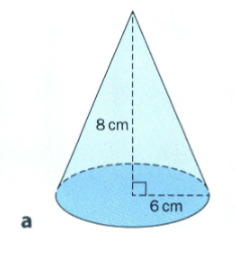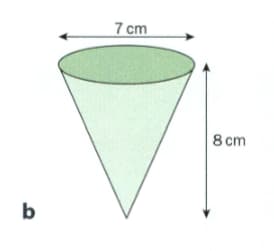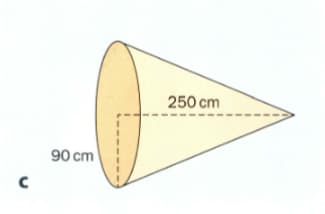Designing tools to explore planets and moons that are very different from our own is one of the problems that NASA continuously has to solve. Often, NASA will propose a solution, build a prototype product and then test it here on Earth first. One such product is the Deep Phreatic Thermal Explorer (DEPTHX), an underwater robot that makes its own decisions on where to go, which samples to collect and even how to get back home.
Created to explore Europa, the smallest of Jupiter's moons, the robot was tested in the El Zacat6n sinkhole in Mexico, the deepest water-filled sinkhole in the world. Sinkholes are the result of natural processes involving acidic rainwater and limestone and they can be found all over our planet.
The depth of the El Zacat6n sinkhole is m, although the depth of the water is only m. The sinkhole can be modelled by a cylinder whose diameter is m. Find the volume of water to the nearest tenths in the sinkhole.

Important Questions on 3D Shapes Products, Processes and Solutions
Designing tools to explore planets and moons that are very different from our own is one of the problems that NASA continuously has to solve. Often, NASA will propose a solution, build a prototype product and then test it here on Earth first. One such product is the Deep Phreatic Thermal Explorer (DEPTHX), an underwater robot that makes its own decisions on where to go, which samples to collect and even how to get back home.
Created to explore Europa, the smallest of Jupiter's moons, the robot was tested in the El Zacat6n sinkhole in Mexico, the deepest water-filled sinkhole in the world. Sinkholes are the result of natural processes involving acidic rainwater and limestone and they can be found all over our planet.
The depth of the El Zacat6n sinkhole is m, although the depth of the water is only m. The sinkhole can be modeled by a cylinder whose diameter is m. Find the percentage of the sinkhole that is filled with water. Show your working.
Designing tools to explore planets and moons that are very different from our own is one of the problems that NASA continuously has to solve. Often, NASA will propose a solution, build a prototype product and then test it here on Earth first. One such product is the Deep Phreatic Thermal Explorer (DEPTHX), an underwater robot that makes its own decisions on where to go, which samples to collect and even how to get back home.
Created to explore Europa, the smallest of Jupiter's moons, the robot was tested in the El Zacat6n sinkhole in Mexico, the deepest water-filled sinkhole in the world. Sinkholes are the result of natural processes involving acidic rainwater and limestone and they can be found all over our planet.
The depth of the El Zacat6n sinkhole is m, although the depth of the water is only m. The sinkhole can be modeled by a cylinder whose diameter is m. A typical Olympic-size swimming pool has a length of m, a width of m and a depth of m. Find the number of Olympic-size pools that could be filled with the water from El Zacat6n (Nearest whole number).
In order to solve the traffic problem in Los Angeles, Elon Musk wants to build an underground tunnel in the shape of a cylinder. He proposes that cars will be placed on electric skates which will enable them to travel much faster than on roadways due to reduced friction and air resistance. The initial tunnel beneath Los Angeles has a diameter of m and a length of km. Find the volume of dirt that had to be removed in order to create the tunnel. Show your working and round your answer to the nearest tenth.
Dating natural formations is not easy, especially examples such as cave formations that may have taken millions of years to create. However, new technologies and processes have been developed to accomplish just that. One of these processes involves measuring the amount of alunite, which is a chalky mineral that forms on cave walls as limestone is eroded from below by sulphuric acid. Another promising method uses radiocarbon dating to find the age of organic material inside the cave. The ability to accurately date caves and the formations in them could be a new tool for scientists hoping to solve the riddle of climate change over the history of our planet. The Watchtower is a column in the Natural Bridge Cavern near San Antonio, Texas. The Watchtower is m tall and has a circumference of m. Find the approximate amount of material in the Watchtower, assuming there are no holes in it.
Dating natural formations is not easy, especially examples such as cave formations that may have taken millions of years to create. However, new technologies and processes have been developed to accomplish just that. One of these processes involves measuring the amount of alunite, which is a chalky mineral that forms on cave walls as limestone is eroded from below by sulphuric acid. Another promising method uses radiocarbon dating to find the age of organic material inside the cave. The ability to accurately date caves and the formations in them could be a new tool for scientists hoping to solve the riddle of climate change over the history of our planet. The Watchtower is a column in the Natural Bridge Cavern near San Antonio, Texas. The Watchtower is m tall and has a circumference of m. The process of forming a column is very slow, with cubic centimeters of a column being added every years. (That's about the size of an ice cube every years!) Find how long it took for the Watchtower to form. Show all of your working and round your answer to the nearest year.
Find the volume of the following shapes. Round your answers to the nearest tenth.

Find the volume of the following shapes. Round your answers to the nearest tenth.

Find the volume of the following shapes. Round your answers to the nearest tenth.

